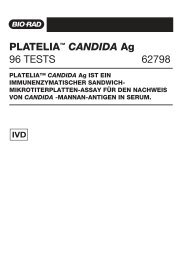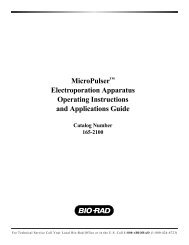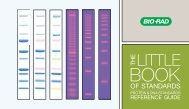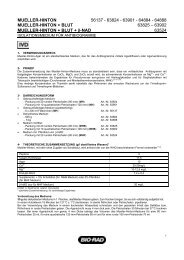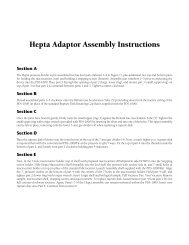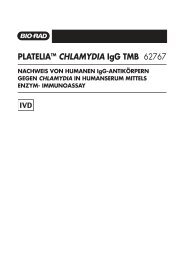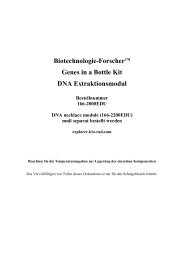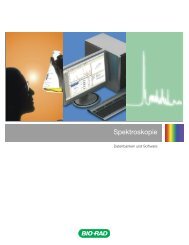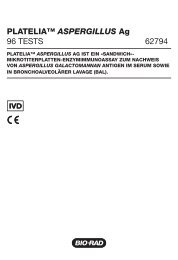Protein Expression and Purification Series - Bio-Rad
Protein Expression and Purification Series - Bio-Rad
Protein Expression and Purification Series - Bio-Rad
Create successful ePaper yourself
Turn your PDF publications into a flip-book with our unique Google optimized e-Paper software.
APPENDIX H<br />
FOCUS QUESTIONS<br />
INSTRUCTORS GUIDE<br />
<strong>Protein</strong> <strong>Expression</strong> <strong>and</strong> <strong>Purification</strong> <strong>Series</strong><br />
Focus Questions: Centrifugaton <strong>and</strong> Chromatography<br />
Instrumentation <strong>Purification</strong><br />
1.<br />
2.<br />
What is gravity chromatography? Name an advantage <strong>and</strong> disadvantage of this system.<br />
Gravity chromatography uses gravity (via nature or centrifugation) to pull the liquid phase through the<br />
solid phase. Advantages of gravity chromatography are that it’s inexpensive <strong>and</strong> does not require any<br />
special laboratory equipment. Disadvantages of gravity chromatography are time <strong>and</strong> the requirement<br />
that someone “baby-sit” the experiment.<br />
Is centrifugation/spin chromatography the same as gravity chromatography? Explain your<br />
answer.<br />
Centrifugation/spin chromatography <strong>and</strong> gravity chromatography both use gravitational force to<br />
push fluids through chromatography columns. Gravity chromatography is limited to 1 x g of force.<br />
Centrifugation/spin chromatography controls the g-force by the speed of the centrifuge. Higher<br />
speeds exert more g-force <strong>and</strong> can increase the flow rate. One difference between the two methods is<br />
that centrifugation/spin chromatography requires a centrifuge <strong>and</strong> columns that fit into that centrifuge.<br />
As a result, gravity chromatography columns can have a larger variety of lengths <strong>and</strong> diameters than<br />
centrifugation/spin chromatography columns.<br />
3. What are the advantages of spin chromatography? When would you choose to use<br />
centrifugation/spin chromatography <strong>and</strong> why?<br />
4.<br />
5.<br />
Spin chromatography is quick, <strong>and</strong> the spin columns fit in a st<strong>and</strong>ard bench-top centrifuge <strong>and</strong> are<br />
available both empty <strong>and</strong> prepacked. If the size of column volume <strong>and</strong> resin can be accommodated,<br />
a centrifuge can generate several thous<strong>and</strong> g-force. This increased force applied to the mobile phase<br />
will pull it through the resin more quickly than 1 x g of force for a gravity column. If the resin packed in<br />
a chromatography column can withst<strong>and</strong> higher forces without being crushed, a spin column can be<br />
faster than a gravity column.<br />
What are the advantages of using prepacked cartridges? When would you choose to use<br />
prepacked cartridges <strong>and</strong> why?<br />
Prepacked cartridges are manufactured to have evenly packed resin beds with no air pockets or<br />
channels. There is a lot of uniformity of performance between cartridges. Large scale chromatography<br />
columns used in the production of biopharmaceuticals are always h<strong>and</strong>packed due to the column size<br />
<strong>and</strong> amount of resin used. Prepacked cartidges are typically only used for bench-scale purifications.<br />
What is a fraction in chromatography?<br />
A fraction is a sample of known volume of eluate from a chromatography column.<br />
238 Appendix H: Focus Question Answers




